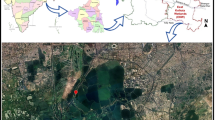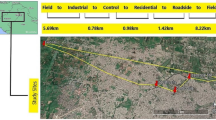Abstract
In situ aquatic and terrestrial plants including a few vegetable and crop plants growing in and around a chloralkali plant at Ganjam, India were analyzed for concentrations of root and shoot mercury. The aquatic plants found to bioconcentrate mercury to different degrees included Marsilea spp., Spirodela polyrhiza, Jussiea repens, Paspalum scrobiculatam, Pistia stratiotes, Eichhornia crassipes, Hygrophila schulli, Monochoria hastata and Bacopa monniera. Among wild terrestrial plants Chloris barbata, Cynodon dactylon, Cyperus rotundus and Croton bonplandianum were found growing on heavily contaminated soil containing mercury as high as 557 mg/kg. Analysis of mercury in root and shoot of these plants in relation to the mercury levels in soil indicated a significant correlation between soil and plant mercury with the exception of C. bonplandianum. Furthermore, the tolerance to mercury toxicity was highest with C. barbata followed by C. dactylon and C. rotundus, in that order. The rice plants analyzed from the surrounding agricultural fields did not show any significant levels of bioconcentrated mercury. Of the different vegetables grown in a contaminated kitchen garden with mercury level at 8.91 mg/kg, the two leafy vegetables, namely cabbage (Brassica oleracea) and amaranthus (Amaranthus oleraceous), were found to bioconcentrate mercury at statistically significant levels. The overall study indicates that the mercury pollution is very much localized to the specific sites in the vicinity of the chloralkali plant.
Similar content being viewed by others
References
Baker AJM (1981) Accumulators and excluders: Strategies in the response of plants to heavy metals. J Plant Nutr 3:643–654
Banuelos G, Schrale G (1989) Plants that remove selenium from soils. California Agric 43:19–20
Brix H, Schierup HH (1989) The aquatic macrophytes in water pollution control. Ambio 18:100–107
Burton MAS (1986) Biological monitoring of environmental contaminants: A technical report. MARC, London, p 247
Cappon CJ (1987) Uptake and speciation of mercury and selenium in vegetable crops grown on compost treated soil. Water Air Soil Pollut 34:353–361
De-Temmerman L, Vandeputte R, Guns M (1986) Biological monitoring and accumulation of airborne mercury in vegetables. Environ Pollut 41:139–151
Environmental Protection Agency (1976) Manual of methods for chemical analysis of water and wastes. U.S. Environmental Protection Agency, National Technical Information Service, Springfield, Virginia, p 298
Fouassin A, Fordu M (1978) Evaluation de la teneur moyenne en mercure de la ration alimentaire en Belgique. Arch Belg Med Soc Hyg Med Trav Med Leg 36:481–490
Gomez KA, Gomez AA (1984) Statistical procedures for agricultural research. John Wiley, NY, p 680
H»kanson L, Nilsson A, Andersson T (1988) Mercury in fish in Swedish lakes. Environ Pollut 49:145–162
Huckabee JW, Diaz FS, Zanzen SA, Solomon J (1983) Distribution of mercury in vegetation at Almaden, Spain. Environ Pollut 30:211–224
Lenka M, Panda KK, Panda BB (1990) Studies on the ability of water hyacinth (Eichhornia crassipes) to bioconcentrate and biomonitor aquatic mercury. Environ Pollut 66:89–99
Lindberg SE, Jackson DR, Huckabee JW, Janzen SA, Levin MJ, Lund JR (1979) Atmospheric emission and plant uptake of mercury from agricultural soils near the Almaden mercury mine. J Environ Qual 8:572–578
Martin MH, Coughtrey PJ (1982) Biological monitoring of heavy metal pollution. Applied Science Publishers, London, P 475
Panda KK, Lenka M, Panda BB (1989) Allium micronucleus (MNC) assay to assess bioavailability, bioconcentration and genotoxicity of mercury from solid waste deposits of a chloroalkali plant, and antagonism of L. Cysteine. Sci Total Environ 79:25–36
Panda KK, Lenka M, Panda BB (1990) Monitoring and assessment of mercury pollution in the vicinity of a chloralkali plant I. Distribution, availability and genotoxicity of sediment mercury in the Rushikulya estuary, India. Sci Total Environ 96:281–296
Panda KK, Lenka M, Panda BB (1991a) Monitoring and assessment of mercury pollution in the vicinity of a chloralkali plant II. Plant-availability, tissue-concentration and genotoxicity of mercury from agricultural soil contaminated with solid waste assessed in barley (Hordeum vulgare L.). Environ Pollut, in press
Panda KK, Lenka M, Panda BB (1991b) Monitoring and assessment of mercury pollution in the vicinity of chloralkali plant III. Concentration and genotoxicity of mercury in the industrial effluent and contaminated water of Rushikulya estuary, India. J Environ Sci Hlth (submitted)
Revis NW, Osborne TR, Holdsworth G, Hadden C (1990) Mercury in soil: A method for assessing acceptable limits. Arch Environ Contam Toxicol 19:221–226
Shaw BP, Panigrahi AK (1986) Uptake and tissue distribution of mercury in some plant species collected from a contaminated area in India: Its ecological implications. Arch Environ Contam Toxicol 15:439–446
Siegel SM, Siegel BZ, Lipp C, Kruckeburg A, Towers GHN, Warren H (1985) Indicator plant soil mercury pattern in mercury rich mining area of British Colombia. Water Air Soil Pollut 25:73–85
Wiersma D, Van Goor BJ, Vander Veen NG (1986) Cadmium, lead, mercury and arsenic concentrations in crops and corresponding soils in The Netherlands. J Agric Food Chem 34:1067–1074
Wolverton BC, McDonald RC (1979) The water hyacinth from prolific pest to potential provider. Ambio 8:2–9
Author information
Authors and Affiliations
Rights and permissions
About this article
Cite this article
Lenka, M., Panda, K.K. & Panda, B.B. Monitoring and assessment of mercury pollution in the vicinity of a chloralkali plant. IV. Bioconcentration of mercury in in situ aquatic and terrestrial plants at Ganjam, India. Arch. Environ. Contam. Toxicol. 22, 195–202 (1992). https://doi.org/10.1007/BF00213285
Received:
Revised:
Issue Date:
DOI: https://doi.org/10.1007/BF00213285




